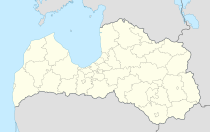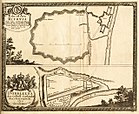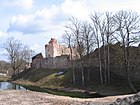Dobele
| Dobele ( German : Doblen) | ||
|---|---|---|
 |
|
|
| Basic data | ||
| State : |
|
|
| Landscape: | Semgallia ( Latvian : Zemgale ) | |
| Administrative district : | Dobeles novads | |
| Coordinates : | 56 ° 37 ' N , 23 ° 17' E | |
| Residents : | 10.113 (Jan. 1, 2016) | |
| Area : | 8 km² | |
| Population density : | 1,264 inhabitants per km² | |
| Height : | ||
| City law: | since 1917 | |
| Website: | www.dobele.lv | |
| Post Code: | ||
| ISO code: | ||
Dobele ( German Doblen ) is a city in southwest Latvia , located on the river Bērze (German Behrse ).
Origin of name
1254 the place name Dubelene or Dubelone was used in a document . Later the terms Doblene , Doblenen and Doblen were also used . The original place name can be reconstructed as Dobelene or Dobeliene , but its origin is connected with the Latvian words " duobe" (pit or depression) and " duobele" (small pit or small depression). Most likely, the place name Dobelene means "inhabited place in a small depression".
history
The first written record came in 1254 when the area was divided between the Bishop of Riga and the Livonian Order . On July 6, 1272 a contract was signed in Riga between Albert Suerbeer , the Archbishop of Riga, Walter von Nordeck, the landmaster in Livonia of the Teutonic Order , and representatives of the subjugated Semgallians . It stipulated the duties that the Semgallians had to pay (§ 1 and § 3), their compulsory labor (§ 2) and their manual and tensioning services in the construction of castles and roads (§ 4). The order assured the Semgallians that the court would judge “according to the law and custom of the country” (§ 5). When the Semgallians rose against the rule of the order, Dobele was a base of the rebels from 1279 to 1290. The castle withstood several attacks by the Teutonic Order. In 1280 the knights under the leadership of Konrad von Feuchtwangen , the 13th Grand Master , besieged the castle and in 1289 under the leadership of Konrad von Hattstein, the landmaster in Livonia . After the surrounding area was devastated and depopulated, the defenders finally withdrew to Lithuanian territory in 1290.
A brick castle of the Teutonic Order was built in the 14th century . During the Polish-Swedish War (1600–1629) the castle was captured by the Swedes.
The reign of Duke Jakob Kettler von Kurland brought economic upswing. In Dobele there were several factories as well as water mills and a sawmill.
During the Second Northern War , the place was temporarily occupied by the Swedes. In 1710 the plague raged . In 1795 Courland became part of the Russian Empire . In 1881 Dobele had 1083 inhabitants. In 1917 Dobele received city rights.
In 1925 city rights were granted. In 1927 Dobele got a train station on the new Jelgava - Liepāja line . The railway line was built because the connection to Liebau / Liepaja ran through Lithuanian territory after the founding of the Baltic states, which was previously insignificant (in the Russian Empire). After the Second World War , the place grew due to the settlement of industry. Not far from Dobele there were two large barracks of the Soviet Army .
In 2009, ten surrounding municipalities merged with the city to form the Dobeles novads district. There are 24,390 registered residents in the district (July 1, 2010).
( See also: Administrative division of Latvia )
Ordensburg Doblen
Only ruins remain of the castle of the Teutonic Order. Archaeological excavations also serve to locate the exact location of the older Semgallic wooden fortress at the same location. The relatively well-preserved castle chapel will be expanded into an exhibition hall with the support of EU funds, in order to accommodate the older part of the historical collection of the Doblen Museum from 2021.
Doblen Museum
The city's local history museum has been located in a former hospital building since 1996. The collection of a total of 23,000 pieces ranges from prehistoric finds to contemporary historical photographs and documents. The permanent exhibition shows a selection of exhibits dating back to the 1940s. Regular special exhibitions present works by local artists and artisans.
Town twinning
There are city partnerships with
-
 Bryansk , Russia
Bryansk , Russia
-
 Schmölln , Germany
Schmölln , Germany
-
 Altenburg , Germany
Altenburg , Germany
-
 Konin , Poland
Konin , Poland
-
 Naujoji Akmenė , Lithuania
Naujoji Akmenė , Lithuania
-
 Joniškis , Lithuania
Joniškis , Lithuania
-
 Tapa , Estonia
Tapa , Estonia
-
 Tukums , Latvia
Tukums , Latvia
-
 Ängelholm , Sweden
Ängelholm , Sweden
-
 Ulricehamn , Sweden .
Ulricehamn , Sweden .
Personalities
- August Bielenstein (1826–1907), from 1867 pastor of the German congregation in Doblen
- Victor von Richter (1841–1891), chemist
- Gustav Otto (1843–1917), doctor and historian
- Siegfried Bielenstein (1869–1949), painter and graphic artist
- Bernhard Bielenstein (1877–1959), Art Nouveau architect
- Leonīds Kalniņš (* 1957), Latvian general
- Alexei Leonidowitsch Kudrin (* 1960), Russian Finance Minister
- Uldis Augulis (* 1972), politician
- Viktors Ščerbatihs (* 1974), weightlifter and politician
- Andris Naudužs (* 1975), racing cyclist
- Lauris Reiniks (* 1979), singer, actor and show master
- Mārtiņs Lībergs (* 1980), handball player
- Ģirts Lilienfelds (* 1982), handball player
- Māris Veršakovs (* 1986), handball player
literature
- Hans Feldmann , Heinz von zur Mühlen (Hrsg.): Baltic historical local dictionary. Part 2: Latvia (South Livland and Courland). Böhlau, Cologne 1990, ISBN 3-412-06889-6 , pp. 114-116.
- Astrīda Iltnere (ed.): Latvijas Pagasti, Enciklopēdija. Preses Nams, Riga 2002, ISBN 9984-00-436-8 .
- Maximilian Lieven: The labor relations of the large estates in Courland. The study of spring 1899 and its results. 7. Delivery: District Doblen. Steffenhagen, Mitau 1903.
Footnotes
- ↑ Friedrich Georg von Bunge (Ed.): Liv-, Esth- and Curländisches Urkundenbuch together with Regesten , Vol. 1: 1093-1300 . Kluge and Ströhm, Reval 1853, Col. 542-544.
- ↑ Hans Feldmann, Heinz von zur Mühlen (ed.): Baltic historical local dictionary. Part 2: Latvia (South Livland and Courland). Böhlau, Cologne 1990, p. 114.
- ^ A b Hans Feldmann, Heinz von zur Mühlen (ed.): Baltic historical local dictionary. Part 2: Latvia (South Livland and Courland). Böhlau, Cologne 1990, p. 115.
- ^ From: Johann Christoph Brotze : Collection of various Liefländischer monuments, prospects and the like . Latviesu Senatnes Petitaju Biedriba, Riga 1926






